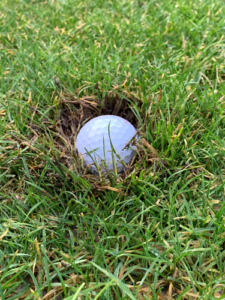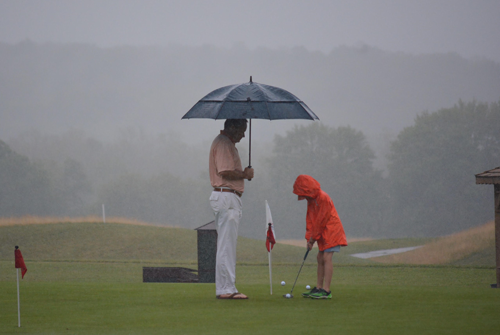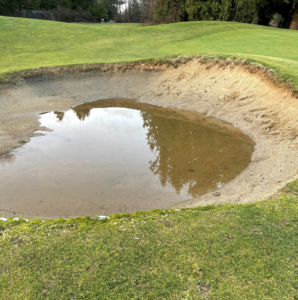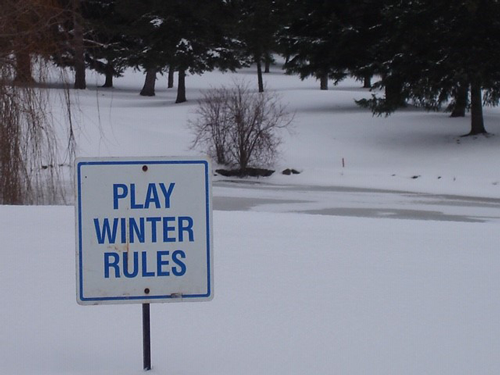‘I’m Swinging in the Rain, Just Swinging in the Rain…’
by Crai S. Bower
When Bryson DeChambeau’s tee shot plugged on the third hole at Augusta National during last November’s Masters, wry smiles broke out across the faces of Pacific Northwest golfers.

Not that we wanted to see the PGA Tour’s latest “Can’t Miss” player have his 2020 Masters chances disappear with his lost ball, but because everyone of us has hit a perfectly good shot only to have it lodge closer to gophers and hobbits than the fairway or green.
Play winter golf here for long enough and you can even tell when your ball plugs from 150 yards away. It’s like that hole-in-one feeling, except it happens a wee bit more often and you don’t have to buy a round after the round.
Disappearing golf balls is just one of many, um, conditions we’ve adapted to when racing the early-setting sun to get in 18 holes. It’s sort of like the children’s book, “I Wish I Had Duck’s Feet,” only the webbed foot is replaced with two gloves, a toque, long underwear, winter boots, and at least four upper layers.
Of course, our brethren in the Midwest and New England might implore us to quit whining. We’re playing golf in December, January, and February, months when their green paradise transforms into cross-country ski trails.
And imagine the Scots, who have every right to lampoon our complaints. The bloody game was, after all, created in a meadow lashed by rain and cloaked in sub 50-degree weather with a wind chill that often turned a fine day frigid – and that’s during a Scotland summer.
Northwest muni golfers maintain a unique rating system in winter, building a “not to play” rota based more on environmental conditions than signature par-3s or par-5s with two-shot potential.

Frequency of temporary green use, those dreaded fairway cups encircled by turf chalk, often tops the list. True, the ball stops like a tour pro’s approach, but who wants to putt through tall grass and various sized lumps of mud?
Speaking of mud, plugging also places high on the list of inhospitable intemperate conditions. Searching for an embedded ball that fell splat in the middle of the fairway or the one that self-buried en route to see Hades just off the apron is as irritating as it is expensive.
With the exception of the tee box, plugging is an equal opportunity mishap. I once thought only wedge approaches were fraught with plugging potential, until my drive actually dug a hole and backed up. Okay, it wasn’t a stellar drive, but I still wasn’t expecting to see a pitch mark 225 yards down the fairway.

Plugged balls aren’t really different than bunker landings, they’re just without the sand. You can have a fried egg with just the top hemisphere of the ball exposed, a buried lie or somewhere in between.
But no need to be discouraged. Gardening season is over, so it’s easy to stow away that trowel in your golf bag for digging up golf balls like last summer’s tulip bulbs.
Plugging is far from the only seasonal variety to winter duffing around here. Consider those bunkers, which, sand be damned, quickly reveal their impervious nature by forming ever deepening pools over the course of the winter.
How you play these “water hazards” reflects how you usually play. Some of us place the ball at water’s edge in the clay, others choose to extract the ball from the bunker altogether, placing it on a tee of grass. No closer to the hole, of course. Hey, it’s winter golf – the heck with the handicap; we can’t post a score anyway.
Playing in the rain and wind requires a definite bounce in your step, a jaunty gait that serves dual purposes by accelerating your round while generating more body heat.
It’s good the energy goes somewhere, because getting bounce off your wedges near the green proves an interesting exercise in adjustments. To stick with the gardening metaphor, your greenside SW or LW tool often becomes more “hoe” than wedge come winter, apparently eager to dig deeply into the soft soil rather than popping gently off the turf, often lofting a swatch of grass toward the hole as the ball sits idly by.

All of this talk about saturated fairways and plugged balls may sound like I’m whining which, I suppose, I am. Yet flying turf and disappearing dimples are small prices to pay for 365 days of potential golf every year. Toss in the ability to ski in the morning and hit the links come afternoon and a besotted bliss is there for the taking.
There’s one other factor that will never dampen the spirits of a local player. Where does the “lift, clean, and place” rule run from early September through July 5th? Only in the Pacific Northwest, that’s where.
So grab your galoshes and tee it up. Soggy days are here again.
Crai S. Bower writes scores of adventure travel articles a year for over 25 publications, including golf stories for American Way, Hearst Media and Journey magazine, among others. He appears regularly on the American Forces Network as a travel commentator. Visit his site at flowingstreammedia.net.





